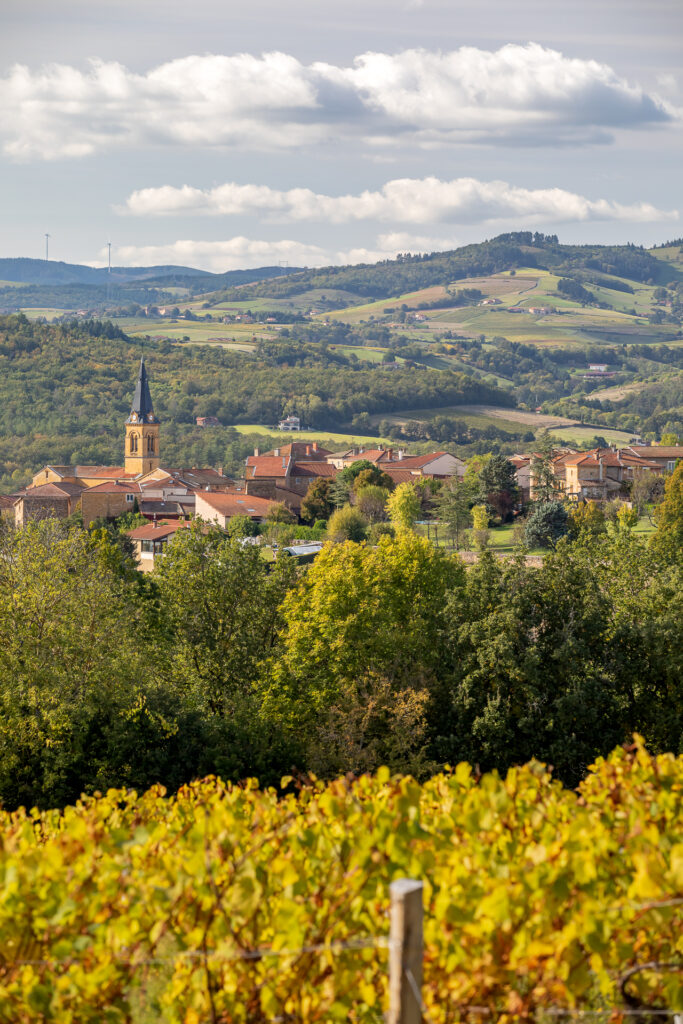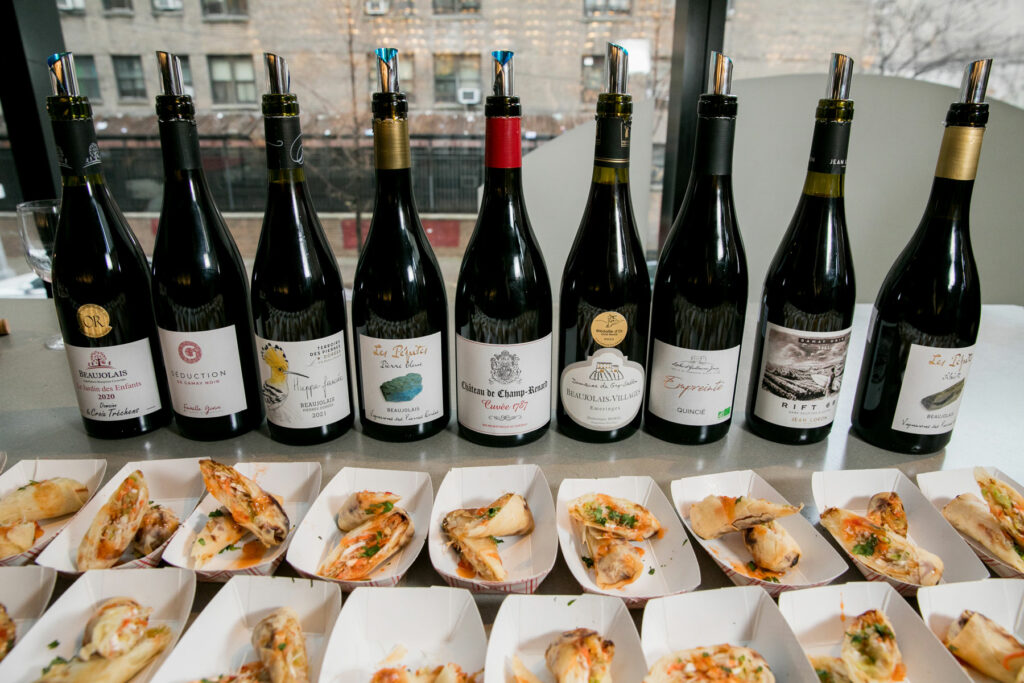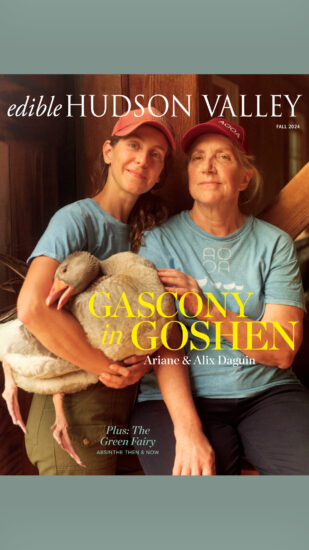The remarkable diversity of the wines of Beaujolais all comes down to terroir, which is defined in Merriam-Webster as “the combination of factors including soil, climate, and sunlight that gives wine grapes their distinctive character.” Though there are some vineyards growing Chardonnay grapes, the wines of Beaujolais are overwhelming made with Gamay grapes—yet the wines that they yield range from rosés and light, party-friendly reds to exceptional, complex wines that merit saving for special occasions.
RELATED: Beaujolais Market, a Wine Takeover at Essex Market
The diversity in the terroirs of Beaujolais starts with its very foundation. The complex geology of Beaujolais, which was designated by the United Nations Educational, Scientific and Cultural Organization as a UNESCO Geopark, means that soils in this region range widely—from sandy and granite-strewn to chalky or clayey. UNESCO defines Beaujolais as having three types of topography: “the Saône River plain at the eastern border, the wine growing area made up of gentle slopes interrupted by wood-covered valleys, and the mountains of Beaujolais extending throughout the west and reaching heights of over 1,000 meters at the regions borders.” According to UNESCO, what makes this region so remarkable (and one of only 17 geoparks in Europe) is that the soil of Beaujolais benefits not only from its topographical features—its river plain, sloped vineyards, and mountains—but also from the rocky remains of the tectonic movements that heaved up the Pyranees and the Alps, and the sediments left by Alpine runoff, the region’s ancient marine history, and the Saone’s own alluvium. Working together, winemakers and geologists have identified 300 different soil profiles in Beaujolais.

The appellations of Beaujolais are comprised of 14,500 hectares of vines, of which 96% are planted with Gamay grapes and 4% with Chardonnay. The terroirs in each of 12 appellations—Beaujolais, Beaujolais Villages, Brouilly, Chénas, Chiroubles, Côte de Brouilly, Fleurie, Juliénas, Morgon, Moulin-à-Vent, Régnié, and Saint-Amour—are created by different combinations of topographical features and soils. Yet even within single vineyards, there are Lieux-Dits, whose grapes yield the finest wines.
Given this incredible complexity, it’s no surprise that the 12 AOCs (Appellations d’Origine Contrôlée, or appellations) of Beaujolais yield vastly different wines. The AOC Beaujolais—in the southern part of the region—features soil with volcanic rock, shale, and limestone from the Mesozoic Era. This soil gives the wine made from Gamay grapes grown here refreshing, crisp qualities—these are full-bodied reds with floral, fruity notes. Nearby, the steep slopes in AOC Beaujolais feature very little limestone and ancient alluvium. This combination of topography and geology yields round, easy-to-drink reds; mineral, floral whites; and lively, fruit-driven rosés.

With the AOC Beaujolais Villages, we begin to discover even more specific landscapes. This appellation refers to the northern part of the vineyard and includes 38 villages. The steep vineyards of granite and ancient alluvium face east-south-east between 200 and 500 meters in altitude and surround the 10 Beaujolais crus of the northern half of the vineyard, where there are as many terroirs as there are villages.
The remaining AOCs of Beaujolais are crus, a term used differently in various winemaking regions; in Beaujolais, crus refer to the AOCs producing the finer vintages of Beaujolais. Brouilly is the largest and most diverse of the Crus Beaujolais, but moderate slopes and granite feature in most of this appellation’s soil. Centrally located in Beaujolais, the granite-laden soil of Brouilly is planted with 100% Gamay grapes that yield round, fruity reds that can be enjoyed as early as the spring following fall harvest. Just to its north, the soil of Côte de Brouilly is full of blue stone and nearly 2/3 of vines grow on steep, stony slopes. This yields expressive, delicate wines. Régnié, which lies north of Côte de Brouilly, features the most granitic of the soils of Beaujolais. Its topography is hilly and features two giant sandstone outcroppings. The wines produced here are refreshing, brilliant, and structured.

AOC Morgon in the northernmost quarter of the region is planted with 100% Gamay grapes. It is second in size only to Brouilly, has three main terroirs, and incredibly diverse soils whose primary components span granite, blue stone, alluvial sediment, clay, schist, etc. The wines produced here are powerful, fleshy, and dense. To the north, AOC Chiroubles features vineyards on the steepest slopes of the 10 crus. While Morgon’s soil is wildly diverse, the soil of Chiroubles is uniformly granite. The wines produced here are fresh, generous, and expressive. Like the soil of Chiroubles, the soil of Fleurie is uniform and granitic; Fleurie’s vineyards are also located on slopes. The wines emanating from Fleurie are luminous, fruity, and delicate. The land registry of Moulin-à-Vent, the appellation just north and east of Fleurie, list 71 terroirs—the result of moderate altitude, primarily south-east exposure, granite slopes, clayey foothills (and large transitional areas between the two). The wines from Moulin-à-Vent are elegant, complex, and powerful.
Chénas, the smallest appellation in Beaujolais, is in the northern reaches of the region just south of Juliénas and Saint-Amour. The west of Chénas features high, steep granite hills, whereas slopes in the east of this appellation are gentler and feature alluvial deposits. Planted with 100% Gamay grapes, the wines produced here are generous, structured, and silky. In Juliénas—north and west of Chénas—steep, south-facing slopes feature soil with blue stone that give way to alluvial plains and clayey subsoils. This yields expressive, fresh, fleshy wines. Finally, just east of Juliénas, Saint-Amour is diverse appellation that features heterogenous pebbly soils—it offers granite, clay, blue stone and alluvial deposits that vary in proportion per vineyard. Nevertheless, the wines from this appellation overwhelmingly are warm and intense; the 100% Gamay grapes grown here yield fruity, tender, and harmonious wines.
RELATED: Beaujolais, the Holiday Wine
Taken in total, the incredible diversity in the combination of geological and topographical features in each appellation make Beaujolais one of France’s most diverse winemaking regions that (paradoxically) is planted with 96% Gamay grapes. It’s a lesson in the meaning of terroir, as one grape yields almost endless expressions. This winter, taste your way through Beaujolais and discover how the nuances of soil make all the difference!
Photos by Lydia Lee Photo
@lydialeephoto



